![]()
![]()
![]()
Use LEFT and RIGHT arrow keys to navigate between flashcards;
Use UP and DOWN arrow keys to flip the card;
H to show hint;
A reads text to speech;
17 Cards in this Set
- Front
- Back
- 3rd side (hint)
|
1. Describe the role of the cerebellum?
2. Describe the sensory info that the cerebellum receives? |
It is currently thought that the cerebellum acts a comparator that compensates for errors in movements by comparing intentions with performance. To achieve this, the cerebellum receives:
1. corollary discharge, internal feedback or efferent copy for intended movement 2. reafference or external (sensory) feedback for actual movement response NOTES: As the cortex execute a movement, they send a copy of this to the cerebellum and the cerebellum makes a plan of what it will do As the execution is taking place, the cerebellum also finds out what is occurring and does its comparison and appropriate adjustments 2. The sensory information that the cerebellum receives is used for the automatic regulation and control of motor function (including posture). Through comparisons of external & internal feedback signals, the cerebellum is able to: 1. correct ongoing movements when they deviate from the intended course 2. modify motor programs in the CNS so that future movements attain their goals, ie. motor learning NOTES: Monitor sensory systems to see if the movements are executed correctly Planning, execution, correction, and learning Send down the cerebellum and the cerebellum makes the plan and sends to supplementary motor cortex, so it is a huge calculator |
|
|
|
What are the 3 major categories of cerebellar afferents and what is the specific connection under one of these categories that is very important?
|
The 3 major categories are:
1.External (Sensory) Feedback 2. Internal Feedback (Efferent Copy) 3. External/Internal Feedback The most important one is: Internal Feedback (Efferent Copy) 3. Cerebral cortex ----pontocerebellar (contralateral)*** NOTE: The output of the cerebellum goes to motor systems of the brain |
|
|
|
Describe the location of the cerebellum in the brain?
|

-The cerebellum is found in the posterior cranial fossa
-The cerebellum forms a roof over the 4th ventricle |
|
|
|
What are tonsils and why are they important?
|
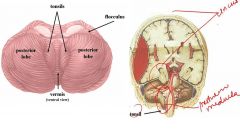
The tonsils are found on the posterior lobe. The tonsils are clinically important when there is an increase in intracranial pressure due to hemmorhage. They can herniate through the foramen magnum and compress the medulla, which is a cardiopulmonary structure, get palsy, and eventually it can cause death.
|
|
|
|
1. What are folia?
|
1. The surface of the cerebellum is extensively folded by (largely) transversely running folia: so they are basically ridges.
|
|
|
|
Describe the effect of ‘Flocculonodular’ & ‘Anterior Lobe’ Syndromes”?
|
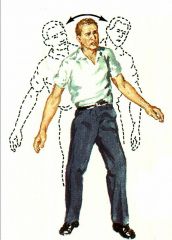
There will be disturbances in equilibrium.
Patient teeters back, forth & sideways Wide-based gait (gait ataxia = uncoordinated walking). degeneration of the anterior lobe is characteristic of alcoholics!! |
|
|
|
1. Illustrate the different inputs into the different sections of the cerebellum?
2. Illustrate the somatotopic organization of inputs to the cerebellum? |

1. SEE DIAGRAM
2. SEE DIAGRAM |
|
|
|
Illustrate the cerebellar outputs?
|
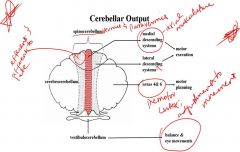
SEE PICTURE
|
|
|
|
Illustrate the magnitide of inputs and outputs traversing each of the 3 cerebellar peduncles?
|
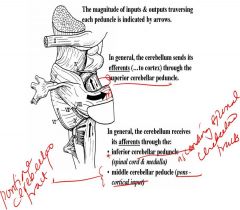
Middle Peduncle: pontocerebellar (contralateral)***:This is the major afferent input from the pons
|
|
|
|
Describe the input of climbing fibers?
|

each Purkinji cells receives input from 1 climbing fiber
a single climbing fiber synapses on 1-10 Purkinji cells climbing fibers provide excitatory and low frequency input climbing fiber input is “all-or-nothing,” (ie., a single action potential in a climbing fiber evokes a complex spike in the Purkinji cell). Most climbing fibers also send collateraly to the deep cerebellar nuclei |
|
|
|
1. Describe the projection of mossy fibers?
2. Describe the source of parallel fibers |
1. Mossy fibers are the major input to cerebellum and they originate from all cerebellar afferents except the inferior olive. Each mossy fiber influences many Punkinji cells indirectly through granule cells (ie., they don’t synapse with Punkinji cells). They provide a high frequency, excitatory input that must be summated to cause spiking of the Purkinji cells.
2. Granule Cell: Source of Parallel Fibers (one of the smallest neurons in the CNS) The axons of granule cells ascend towards the surface even though their cell body is still in the granular layer and the axons split in the molecular layer & runs parallel to the folia. The parallel fibers can make 2 to 3 synapses with a single purkinje fiber. |
|
|
|
Relate the mossy fibers to purkinji cells?
|
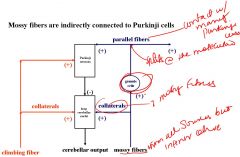
Mossy fibers are indirectly connected to Purkinji cells
|
|
|
|
Illustrate the cerebellar output of the 4 deep cerebellar nuclei?
|
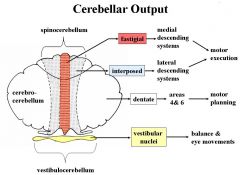
SEE DIAGRAM
|
Plan date
|
|
|
Describe the corticopontine tract specifically mentioning its origination and its role in the cerebellum?
|
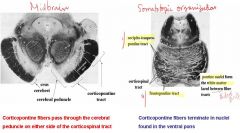
The cerebellum receives its MAJOR input from the cortex which is relayed through the pons.
The corticopontine tract originates primarily from: 1. premotor cortex (area 6) 2. motor cortex (area 4) 3. somatosensory cortex (areas 3, 1, 2) 4. higher order somatosensory cortex (area 5) Pontocerebellar fibers cross in the pons & reach the cerebellum via the middle cerebellar peduncle. Therefore, Efferents from pontine nuclei form mossy fibers terminating primarily in the contralateral cerebrocerebellum due to the crossing they make. |
High PMS
|
|
|
1. Describe the efferent connection of the dentate nucleus?
2. Why are cerebellar lesion signs usually ipisilateral? |
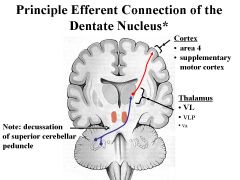
1. The dentate nucleus projects via the superior cerebellar peduncle to the contralateral red nucleus and a small portion of dentate efferents synapse in the red nucleus (parvocellular part) before being relayed to the ventral lateral nucleus of the thalamus (sensory relay) & then finally to area 4 and area 6 of the cortex.
2. Cerebellar lesion signs are usually ipsilateral to the site of the lesion because the decussations of the cerebellothalamic tract and lateral spinal thalamic tract. So there is double decussation that cancels out each other. |
|
|
|
What are 4 dysfunctions due to lesions of the cerebellar cortex?
|
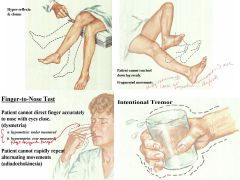
Lesion of the cerebellar cortex delays the initiation of movement.
Classical conditioning is achieved through the cerebellum so it is important in motor learning |
HIFFi
|
|
|
What are 4 dysfunctions due to lesions of the cerebellar cortex?
|
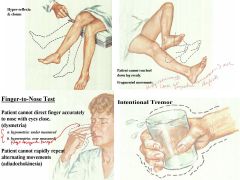
Lesion of the cerebellar cortex delays the initiation of movement.
Classical conditioning is achieved through the cerebellum so it is important in motor learning |
HIFFi
|

